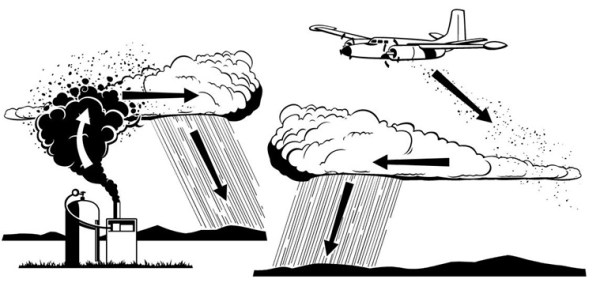

11th November 2023 (8 Topics)
Context:
Cloud seeding has only been done earlier with the purpose of bringing rainfall to drought-prone areas, and not to mitigate pollution.
Background:
- The Delhi government had announced cloud seeding or ‘artificial rain’ to wash away pollutants in the air.
- The now mooted proposal has been attempted previously in India but only in the monsoon season – when clouds with moisture are present – and pre-monsoon months. Besides, it has only been done before in the country with the purpose of bringing rainfall to drought-prone areas, and not to mitigate pollution.
About cloud seeding:
- Condensation: Water vapour condenses around small particles to form the droplets that make up a cloud. These droplets collide and grow; as they get heavy and the cloud gets saturated, it rains.
- Cloud Seeding Salts: With cloud seeding, clouds are usually injected with salts like silver iodide, potassium iodide, or sodium chloride, which is the ‘seed’. These salts are expected to provide additional nuclei around which more cloud droplets can form. They are dispersed into the cloud either using aircraft or through generators on the ground.
- Microphysical process: Seeding accelerates cloud microphysical processes, a sufficiently large droplets must be formed that can reach the surface of the earth and not evaporate on the way.
- Cloud condensation nuclei and ice nuclei: The substance that is dispersed into the cloud needs to have cloud condensation nuclei and ice nuclei and these two come from two different salts.
- Cloud droplets: The cloud condensation nuclei help form cloud droplets, and ice nuclei help to form ice crystals. Ice crystals grow faster than drops, and they become large and fall.

What are the conditions required for cloud seeding to be done?
- Firstly, cloud cover and clouds of a certain type are necessary.
- Cloud seeding can only happen if there is a sufficient number of clouds and a particular depth to these clouds.
- Inside, there needs to be an adequate number of cloud droplets.
- Cloud seeding is done to increase the radius of the cloud droplets so that they will grow bigger and because of gravity, they will come down as rainfall.
- But with a clear sky, cloud seeding in not possible.
Has cloud seeding been done before in India, and has it been successful?
- Previous Cloud Seeding: Seeding has mostly been attempted during the monsoon in India, in places such as Karnataka, Maharashtra and Tamil Nadu.
- Cloud Aerosol Interaction and Precipitation Enhancement Experiment (CAIPEEX-IV): A more recent experiment, the fourth phase of the Cloud Aerosol Interaction and Precipitation Enhancement Experiment (CAIPEEX-IV) that took place in the monsoon seasons of 2018 and 2019, was conducted in drought-prone Solapur in Maharashtra. It pointed to a relative enhancement of 18 per cent in rainfall.
- Complex Cloud Microphysics: Cloud microphysics is more complicated than we think. We can get some advantage from it in the monsoon season if there are enough clouds. When you seed, all clouds won’t rain, and even without seeding clouds can rain. It is still a very complex and uncertain field of research.
Can cloud seeding help with pollution levels?
- In India so far, cloud seeding has not been tried with the purpose of reducing pollution, but only been tried to deal with drought-like conditions.
- There are a few cases where China tried weather management In India, we don’t have investigations done in this aspect (impact of cloud seeding on pollution).
- The conditions in India are different, and we will need a dedicated study on this. Clouds and their processes are very complex, these are non-linear processes. If you do something, it is not known exactly that it is going to give you this much rain or not.
More Articles


